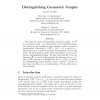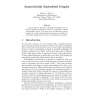402 search results - page 2 / 81 » On Finding the Number of Graph Automorphisms |
DM
2010
13 years 5 months ago
2010
A labeling of a graph G is distinguishing if it is only preserved by the trivial automorphism of G. The distinguishing chromatic number of G is the smallest integer k such that G ...
JGT
2006
13 years 5 months ago
2006
We begin the study of distinguishing geometric graphs. Let G be a geometric graph. An automorphism of the underlying graph that preserves both crossings and noncrossings is called...
EJC
2006
13 years 5 months ago
2006
The general symplectic graph Sp(2, q) is introduced. It is shown that Sp(2, q) is strongly regular. Its parameters are computed, its chromatic number and group of graph automorphis...
ARSCOM
2005
13 years 5 months ago
2005
Can an arbitrary graph be embedded in Euclidean space so that the isometry group of its vertex set is precisely its graph automorphism group? This paper gives an affirmative answe...
EJC
2008
13 years 5 months ago
2008
The distinguishing number D(G) of a graph G is the least integer d such that G has a labeling with d labels that is preserved only by a trivial automorphism. We prove that Cartesi...


